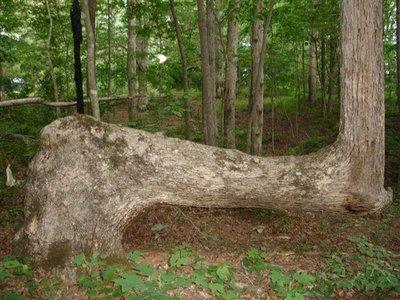On our mountain there are a good many trees that nature bent. We are up high enough that we have a regular breeze in the summer and a bit of wind in the winter. There is a special project not too far from here celebrating some bent trees that nature did not shape, rather Native Americans and the Cherokee used them as trail markers.
Imagine a scene back in time, more than 200 years ago, when a young Cherokee Indian might be found striding quietly through the dense wilderness of North Georgia. He might be in search of water, a sacred burial site, or perhaps even a specific kind of medicinal plant. This young Cherokee could only rely on nature to guide him. For him, the trees could speak. The young poplars and supple white and red oaks, species that can live hundreds of years, spoke the language of his forefathers. Saplings would be bent parallel to the ground and tied down, the crook sometimes being formed with a yoke or Y-shaped branch. A year or so later, the trees would be trained upward and tied off so that the leader pointed upward. If a branch or shoot had begun growing vertically, the leader would be cut off, creating a “nose” that is one of the bent tree’s distinctive features. Researchers believe the Cherokee shaped the trees to form a system of signs pointing to things that hunters, gatherers and warriors needed on journeys that could entail hundreds of miles. Working with nature, by doing something as simple as bending a tree to show the way, left little to no impact on their world but had a huge impact on the ability to travel swiftly along very long passages.

Colonial military documents suggest Cherokee soldiers could run the Warrior Trail into Pennsylvania in five days, averaging at least 100 miles a day. One historical record from the 1750s stated that Cherokee warriors were in Maryland, ready for battle, within days of being summoned by the British, who wanted help in their fight against the French. The British commander marveled that the warriors had arrived far earlier than British troops garrisoned not far away.
Although there are skeptics that say no one would have taken the time to do this, they simply knew their way around, I believe! A nation that knew how to travel far and wide, trade and find medicines in what we now call “another state” and passed on oral knowledge faithfully as long as the tribe was together, would have taken the time to share that knowledge.
The Trail Tree Project ; Hiking along the crest of our mountain ridge in North Georgia, one has little question that the bent trees along the path are the living relics of a lost civilization. This Mountain Stewards’ Trail Tree Project is an attempt to answer some of the questions about these trees, and to provide a documented record of their legacy, before time, disease, and urbanization destroy them. You can go to the Trail Tree Project and submit pictures of what you might think could be a trail tree. If indeed it is found to be one, it will be added to the data base. Help this project document as much as possible before these trees are gone. Be that elder with the time to pass on knowledge!
Thank you so much for spending some time with us today and as always,
WELCOME TO THE MOUNTAINS
